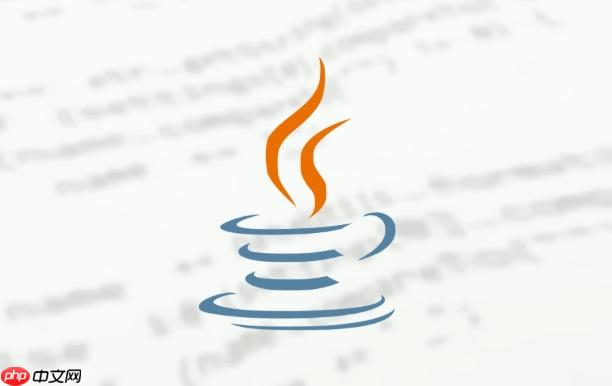Executors是Java中用于快速创建线程池的工具类,提供newFixedThreadPool、newSingleThreadExecutor、newCachedThreadPool和newScheduledThreadPool等方法,适用于不同任务场景;但因其默认使用无界队列或无限线程创建,存在内存溢出和资源耗尽风险,生产环境推荐手动配置ThreadPoolExecutor以精确控制线程池参数,并通过shutdown、awaitTermination等方法优雅关闭线程池,避免资源泄漏。

在Java中,Executors 是一个工具类,提供了静态方法来创建不同类型的线程池。它简化了线程池的初始化过程,让开发者可以快速构建适合特定场景的线程管理机制。虽然推荐在生产环境中使用 ThreadPoolExecutor 手动配置以获得更好的控制力,但在学习或轻量级项目中,Executors 依然是一个实用的选择。
1. 常见的线程池类型及创建方式
通过 Executors 可以快速创建以下几种常用的线程池:
- newFixedThreadPool(int nThreads):创建固定数量线程的线程池。适用于负载较重但任务数量可预期的场景。
- newSingleThreadExecutor():仅有一个工作线程,保证任务按顺序执行,适合需要串行处理的任务。
- newCachedThreadPool():根据需要创建新线程,空闲线程会被缓存60秒。适合大量短时间异步任务。
- newScheduledThreadPool(int corePoolSize):支持定时和周期性任务执行。
示例代码:
import java.util.concurrent.ExecutorService; import java.util.concurrent.Executors; public class ThreadPoolExample { public static void main(String[] args) { // 创建固定大小为3的线程池 ExecutorService fixedPool = Executors.newFixedThreadPool(3); for (int i = 0; i < 5; i++) { final int taskId = i; fixedPool.submit(() -> { System.out.println("任务 " + taskId + " 正在由线程 " + Thread.currentThread().getName() + " 执行"); try { Thread.sleep(2000); } catch (InterruptedException e) { Thread.currentThread().interrupt(); } }); } // 关闭线程池 fixedPool.shutdown(); } }
2. 定时任务线程池的应用
当需要延迟执行或周期性运行任务时,ScheduledExecutorService 是更合适的选择。
- 使用 Executors.newScheduledThreadPool(corePoolSize) 创建。
- 调用 schedule(Runnable command, long delay, TimeUnit unit) 实现延时执行。
- 使用 scheduleAtFixedRate 或 scheduleWithFixedDelay 实现周期调度。
示例:每3秒打印一次日志
import java.util.concurrent.Executors; import java.util.concurrent.ScheduledExecutorService; import java.util.concurrent.TimeUnit; public class ScheduledTask { public static void main(String[] args) { ScheduledExecutorService scheduler = Executors.newScheduledThreadPool(2); scheduler.scheduleAtFixedRate(() -> { System.out.println("定时任务执行: " + System.currentTimeMillis()); }, 1, 3, TimeUnit.SECONDS); // 延迟1秒后开始,每3秒执行一次 // 注意:定时任务不会自动停止,需手动调用 shutdown Runtime.getRuntime().addShutdownHook(new Thread(scheduler::shutdown)); } }
3. 使用注意事项与潜在风险
尽管 Executors 提供了便捷的创建方式,但也存在一些容易被忽视的问题:
立即学习“Java免费学习笔记(深入)”;
- newFixedThreadPool 和 newSingleThreadExecutor 使用的是无界队列(LinkedBlockingQueue),如果任务提交速度远大于处理速度,可能导致内存溢出(OOM)。
- newCachedThreadPool 允许创建无限多线程,在高并发下可能耗尽系统资源。
- 缺乏对拒绝策略、队列容量等关键参数的显式控制。
因此,在生产环境建议直接使用 ThreadPoolExecutor 构造函数,明确指定核心线程数、最大线程数、空闲时间、工作队列和拒绝策略。
4. 正确关闭线程池
不关闭线程池会导致 jvm 无法正常退出。应使用标准流程释放资源。
- 调用 shutdown() 启动有序关闭,不再接收新任务,已提交任务继续执行。
- 配合 awaitTermination() 设置等待超时,确保任务完成。
- 必要时调用 shutdownNow() 尝试中断正在运行的任务。
优雅关闭示例:
executor.shutdown(); try { if (!executor.awaitTermination(60, TimeUnit.SECONDS)) { executor.shutdownNow(); // 强制关闭 } } catch (InterruptedException e) { executor.shutdownNow(); Thread.currentThread().interrupt(); }
基本上就这些。掌握 Executors 的常见用法有助于快速开发,但也要清楚其限制,避免在关键系统中埋下隐患。


